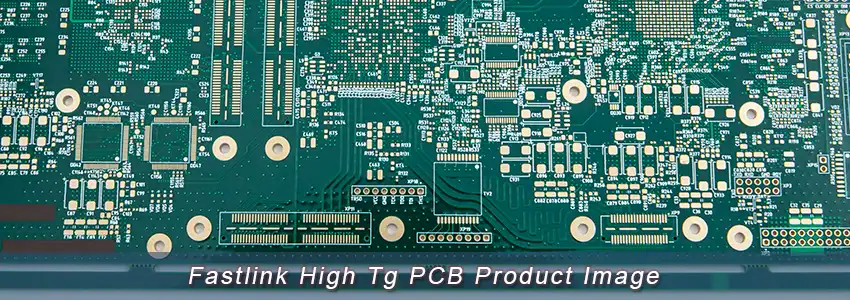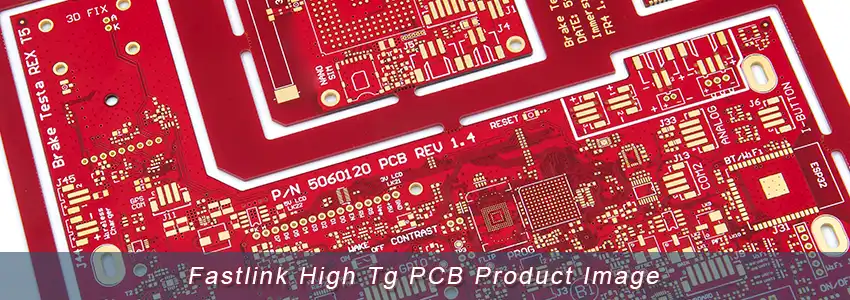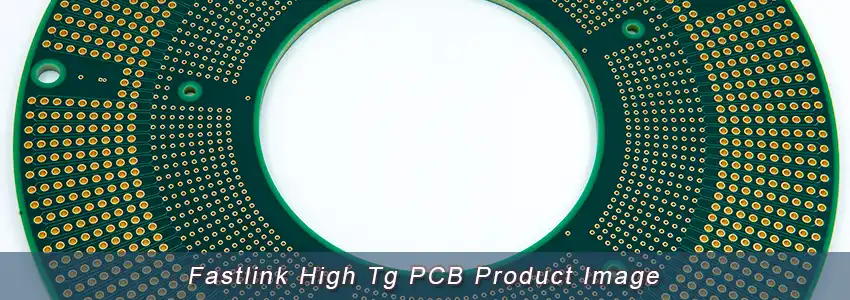- +86-0755-23597570-6067 Mon-Sun 0. 00-23. 59

The reliability of a PCB significantly hinges on the correct selection of material for the laminate. Three parameters are central in this regard— the glass transition temperature (Tg), Coefficient of Thermal Expansion (CTE), and the Decomposition Temperature (TD).
The Glass Transition Temperature, abbreviated as “Tg,” signifies the juncture at which the PCB material begins transforming. It is a crucial parameter for the base material as it determines the temperature at which the resin matrix transitions from a rigid, non-elastic state to a soft, elastic state. The Tg value for the base material essentially establishes an upper temperature threshold, beyond which the resin matrix commences decomposition, leading to the PCB’s delamination. Hence, Tg does not represent the maximum operational temperature for the PCB, but rather a temperature the material can withstand for only a brief period.
Fastlink, a specialized PCB manufacturer from China, possesses rich expertise in the production of High-Temperature Circuit Boards and High TG PCBs, offering high-quality manufacturing services for High TG Circuit Boards. We have perfect after-sales service and technical support, which can ensure customers have a good experience.
The glass transition temperature (Tg) signifies the point at which substrate morphs from a glassy, rigid state to a more rubbery state. Boards with a high Tg are engineered to function optimally at elevated temperatures. A PCB is categorized as a high Tg board if its Tg exceeds 180°C.
Typical FR-4 boards exhibit a Tg ranging from 130 to 150°C. In contrast, high-temperature PCBs present enhanced mechanical and chemical resilience to heat and moisture when compared to FR-4 boards. A higher Tg value denotes improved temperature resistance of the material.
As the board temperature surpasses the Tg value, the substrate experiences structural alterations, leading to a loss in both mechanical and electrical properties of the circuit board. This scenario sets the stage for various board failures. Once the temperature descends below the Tg value, the circuit board reverts to its original state.
In alignment with RoHS and WEEE stipulations, contemporary electronic equipment abstain from utilizing hazardous substances. During the assembly phase, lead-free processes operate at a higher temperature compared to their leaded counterparts. Consequently, materials boasting a higher Tg value find themselves more sought after.
In board design, operating temperature is a pivotal factor as it bears a direct influence on reliability. High Tg materials are versatile, finding use in both rigid and flex boards. Here are a few considerations favoring the selection of high Tg PCBs over standard boards:
High Tg boards generally outperform standard FR-4 boards in terms of reliability due to their enhanced thermal, chemical, and mechanical attributes. This leads to a reduction in the likelihood of short circuits and various other board failures when operating in high-temperature environments.
HDI/multi-layer boards, with their complex electronic circuits and densely populated components, engender higher heat generation compared to standard circuit boards. Employing high Tg materials mitigates this issue effectively.

By PCB industry standards, the typical Tg (Glass Transition Temperature) for standard PCB FR4 is 130-140 degrees, medium Tg ranges above 150-160 degrees, and high Tg exceeds 170 degrees.
The distinction between general FR-4 and high Tg FR-4 primarily revolves around mechanical strength, adhesion, water absorption, dimensional stability, and thermal decomposition in a heated state. Particularly after water absorption, the disparities in thermal expansion under various conditions become pronounced. High Tg FR-4 PCBs exhibit enhanced performance compared to standard FR-4 PCBs. Owing to these advantages, the demand for high Tg PCBs has surged in recent years, albeit at a price premium over standard FR-4 PCBs.
High Tg PCBs are crucial for protecting your printed circuit boards from the high temperatures encountered in your application process or during the extreme temperatures of lead-free assembly. However, it’s prudent to explore various methods to divert the intense heat generated by electronic applications from your board.
The core methodologies for dissipating the excessive heat generated by electronics within printed circuit boards include convection, conduction, and radiation. Convection transfers heat to air or water, enabling it to flow away from a designated area, often with the aid of fans or pumps to facilitate air movement over the surface. In a majority of printed circuit boards, a convection system prevails, where convection, often paired with a cooling air fan, channels the heat through thermal vias to sizable, emissive heat sinks tethered to conductive backings.
Conduction cooling operates by placing the heat sink in direct contact with the heat source, enabling the heat to drift away from the source much like how electrical current navigates through a system. Designers mitigate radiation heat by ensuring a direct path for electromagnetic waves to veer away from the source. Although electromagnetic wave radiation isn’t a massive heat generator, if the board incorporates reflective surfaces in the path of these waves, a rebound effect can occur, significantly amplifying the heat radiation generates on the board.
It’s apparent that the degree of heat you need to manage directly impacts the design of the board. Diminishing power density may curtail your product’s effectiveness, while the addition of heat sinks and fans can augment size, weight, and cost. Therefore, even with an understanding of other effective heat management methods, making high Tg materials an integral part of an overall heat control solution is arguably the right choice.
1. Improved Thermal Stability: High Tg PCBs showcase enhanced thermal stability which is crucial during the soldering process and in operational environments with fluctuating temperatures.
2. Better Mechanical Strength: They exhibit improved mechanical strength which is beneficial in maintaining structural integrity under thermal stress.
3. Low Coefficient of Thermal Expansion (CTE): High Tg materials have a low coefficient of thermal expansion which minimizes the risk of mechanical deformation during heating and cooling cycles.
4. Enhanced Chemical Resistance: High Tg PCBs are more resistant to harsh chemicals which can be advantageous in certain industrial applications.
5. Extended Lifespan: The enhanced thermal, mechanical, and chemical resistance attributes contribute to a longer lifespan of High Tg PCBs even in demanding operational environments.
6. Reduced Risk of Failure: Their ability to withstand thermal stress reduces the likelihood of failure like delamination, thermal warping or electrical failure, thereby enhancing the overall reliability of the electronic assembly.

1. Aerospace and Defense: In aerospace and defense sectors, electronics are exposed to extreme temperature variations and harsh conditions. High Tg PCBs are crucial for applications like radar systems, communication systems, control systems, and other critical electronic components due to their ability to withstand high temperatures and maintain integrity under thermal stress.
2. Automotive: Modern automotive electronics are subject to high temperatures, especially under-the-hood applications. High Tg PCBs find applications in engine control units, anti-lock brake systems, power steering systems, transmission control, and other critical systems which require reliable performance under elevated temperatures.
3. Industrial Electronics: Industrial electronic applications like power converters, automation controllers, and monitoring systems often operate in environments with high temperatures. High Tg PCBs are chosen for their reliability and thermal stability.
4. Telecommunications: Telecommunication equipment such as routers, switches, and signal systems demand reliable performance and thermal stability, making High Tg PCBs a suitable choice to ensure uninterrupted communication services.
5. Medical Devices: High Tg PCBs are utilized in medical electronics for their reliable performance. Devices like diagnostic equipment, monitoring systems, and imaging systems benefit from the thermal stability and mechanical strength of High Tg PCBs.
6. LED Lighting Systems: The heat generated by LEDs can be significant, especially in high-power applications. High Tg PCBs are preferred for their ability to withstand the heat and maintain performance, ensuring the longevity and reliability of LED lighting systems.
7. Consumer Electronics: High-performance consumer electronics such as high-speed computers, gaming systems, and home entertainment systems may also benefit from the use of High Tg PCBs, especially as these devices become more compact and powerful.
8. High-Frequency Systems: High-frequency systems benefit from High Tg PCBs due to their low dielectric loss which is crucial for maintaining signal integrity.
| Item | Fabrication Capability |
| Materials | FR4, Shengyi, ISOLA, TUC, Rogers, Nelco, Taconic, Arlon etc. |
| Layer Count | 4-36 Layer |
| Laser Drilling | 3Mil |
| TG | >170° |
| TD | >345° |
| Board Thickness Tolerance | 10% |
| Finish Copper Thickness | 1-20OZ |
| Surface Finishing | Immersion Gold, Plating Nickel, Immersion Silver, OSP, Hard Gold, Enepig, HASL lead free |
| Solder Mask | Green, Red, Yellow, Blue, White, Black, Purple, Matte Black, Matte green |
| Silkscreen | Green,Yellow, White, Black |
| Via Process | Tenting Vias, Plugged Vias, Vias not covered |
| Testing | Fly Probe Testing (Free) and A.O.I. testing |
| Delivery Time | 3-10 Working days |
| Aspect ration | 12:1 |
With over a decade of PCB manufacturing expertise and profound engineering experience, Fastlink can help you design and build High Tg PCBs. We can manufacture High-Tg Circuit Boards with a Tg value exceeding 180°C. In addition, we also provide customers with metal-based PCBs with excellent heat dissipation performance, including aluminum PCBs, LED PCB circuit boards, metal core PCBs, and copper PCBs.
We can provide FR4 PCBs and other high-TG PCBs that are tailored to meet the specific requirements of your PCB project. If you are uncertain about whether your applications necessitate the use of high-TG PCBs or have any other specific requirements, please feel free to reach out to us. Our team of experienced engineers at Fastlink will assist you in analyzing your project and provide you with appropriate recommendations and guidance.

Our 65,000-square-foot state-of-the-art facility in Shenzhen houses the advanced equipment for manufacturing and assembling printed circuit boards. Fastlink leads the industry in quality and performance, whether you need standard fast PCBs or metal PCBs with tight tolerances.
There are more pictures of our factory’s equipment display in our company profile, please click here.
We are duly certified with the following accreditations:
● IATF 16949:2016
● ISO 9001:2015
● ISO14001:2015
● ISO13485:2016
● UL
Furthermore, all our products adhere to the IPC & ROHS Standards. It is our continuous endeavor to produce premium quality PCB products.
